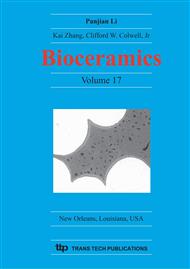p.59
p.63
p.67
p.71
p.75
p.79
p.83
p.89
p.93
Control of Crystal Orientation of Hydroxyapatite by Imposing a High Magnetic Field
Abstract:
The controlled development of texture microstructure in ceramics is one effective way to improve their properties, such as electrical, mechanical properties and biocompatibility. A bioceramics with oriented crystal structure has attracted great interest. In bone reparations, Hydroxyapatite (HAp)-based biomaterials were frequently used. And HAp is the main mineral constituent of the hard tissue of human bodies, which occurs with a hexagonal crystal. A HAp crystal turns out to have different surface properties in a- (or b-) plane and c-plane. In this regard, to get highly oriented HAp is very important before using HAp as a biomaterial. And the crystal orientated HAp is useful not only as biomaterials but also as protein absorbents. In this research, two different kinds of HAp-based biomaterial with oriented structure (HAp bioceramics and HAp-coated titanium composite) were studied.
Info:
Periodical:
Pages:
75-78
Citation:
Online since:
April 2005
Authors:
Keywords:
Price:
Сopyright:
© 2005 Trans Tech Publications Ltd. All Rights Reserved
Share:
Citation:


